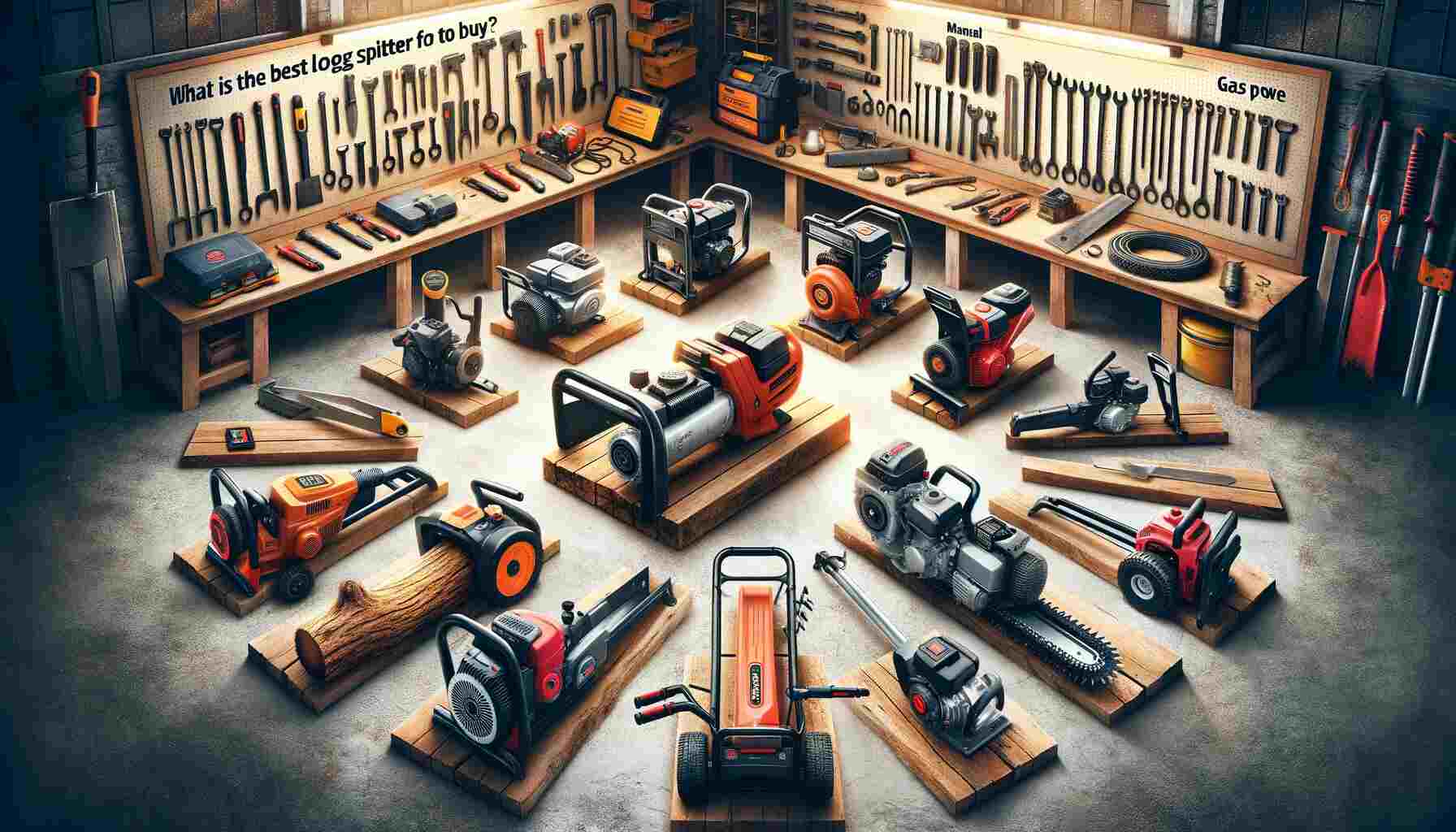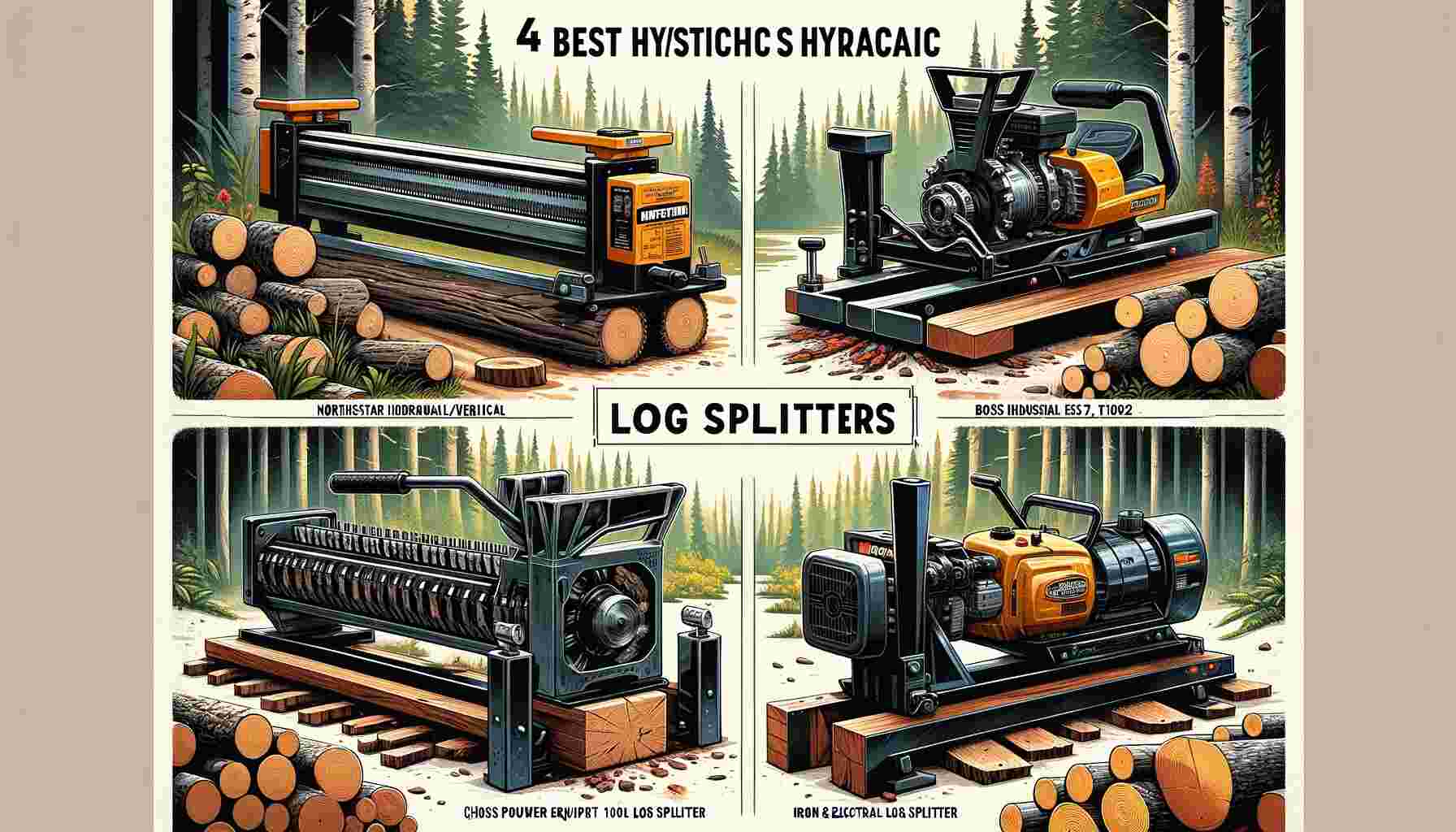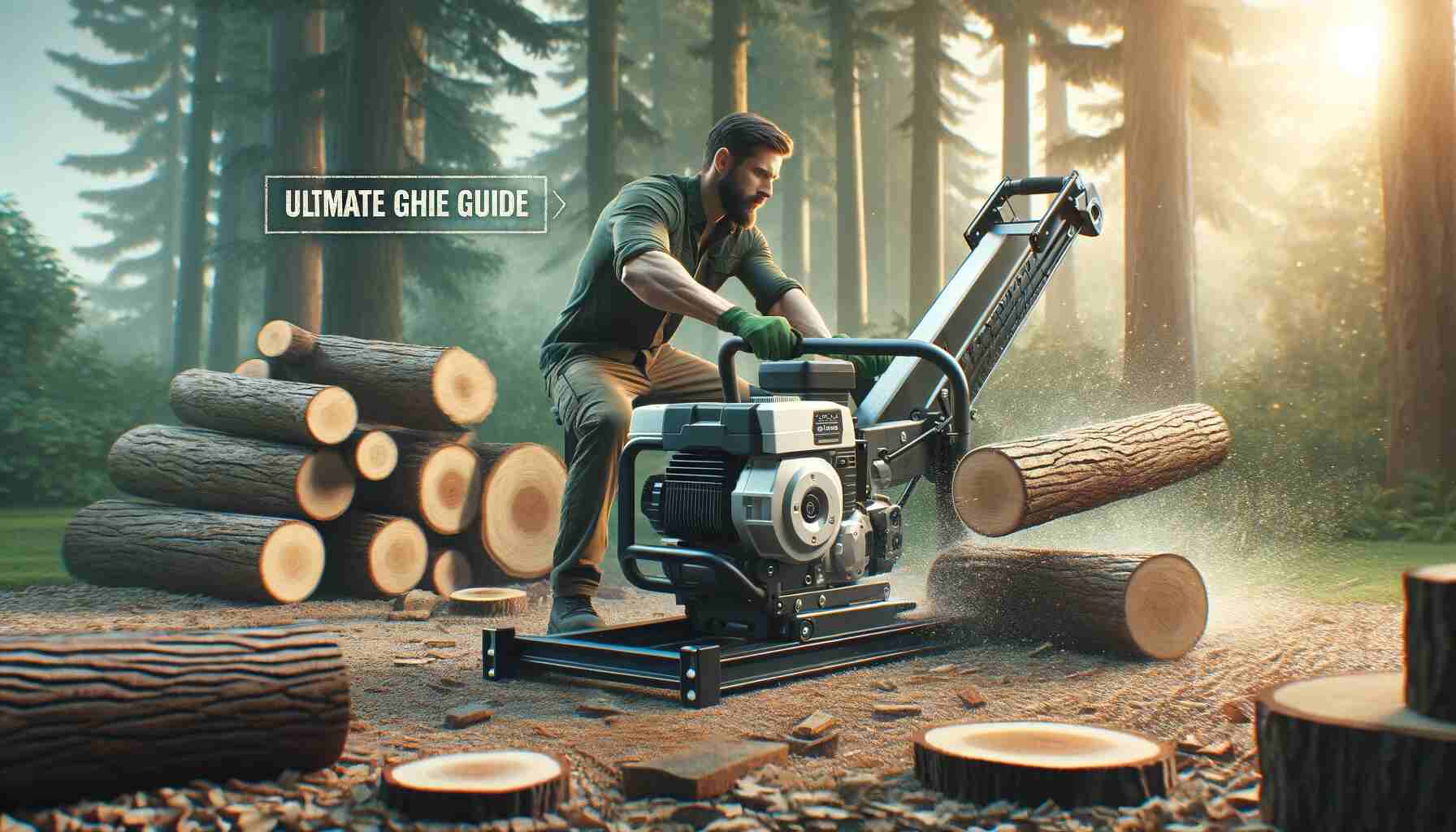When it comes to splitting logs for firewood, a hydraulic log splitter can be a game-changer. Whether you’re a seasoned firewood enthusiast or just someone looking to make your wood-chopping tasks easier, finding the best hydraulic log splitter is essential.
In this article, we’ll cover hydraulic log splitters in detail, including types, features, safety tips, and expert recommendations to help you choose the best hydraulic log splitter for your needs.
Types of Log Splitters
Before we dive into the specifics of hydraulic log splitters, let’s briefly explore the different types of log splitters available on the market.
Manual Log Splitters
- Operated by hand or foot.
- Suitable for occasional use and small logs.
- Affordable but requires physical effort.
Electric Log Splitters
- Powered by electricity.
- Ideal for medium-sized logs.
- Offer a good balance between power and convenience.
Gas-Powered Log Splitters
- Run on gasoline or diesel.
- Suitable for heavy-duty tasks and large logs.
- Provide maximum power but can be noisy and emit fumes.
Hydraulic Log Splitters
- Operate using hydraulic pressure.
- Highly versatile and suitable for various log sizes.
- Known for their efficiency and power.
What Size Log Splitter Do You Need?
The size of the log splitter you need depends on the diameter and length of the logs you plan to split. Here are some general guidelines:
- Small Log Splitter (under 20 tons):
- Suitable for logs up to 12 inches in diameter and 18-24 inches in length.
- Ideal for residential use and smaller firewood needs.
- Medium Log Splitter (20-30 tons):
- Can handle logs with diameters up to 18 inches and lengths of 24-30 inches.
- Good for moderate to heavy-duty residential use and small-scale commercial use.
- Large Log Splitter (30+ tons):
- Designed for logs with diameters over 18 inches and lengths exceeding 30 inches.
- Suitable for heavy-duty commercial or industrial use and large-scale firewood production.
Ultimately, the size you need depends on your specific requirements. Consider the size and volume of logs you’ll be splitting regularly, as well as the intended frequency of use, to determine the right log splitter size for your needs.

What Is The Best Log Splitter For You to Buy?
The best log splitter to buy depends on your specific needs, budget, and preferences. Here are some top-rated log splitters in different categories to consider:
- Gas-Powered Log Splitter:
- Champion Power Equipment 27-Ton Gas Log Splitter: Known for its power and reliability.
- Electric Log Splitter:
- WEN 56207 6.5-Ton Electric Log Splitter: A compact and efficient choice for residential use.
- Hydraulic Log Splitter:
- NorthStar Horizontal/Vertical Log Splitter: Offers versatility with both horizontal and vertical splitting options.
- Kinetic Log Splitter:
- Boss Industrial ES7T20 Electric Kinetic Log Splitter: Known for its speed and efficiency.
- Manual Log Splitter:
- Sun Joe LJ10M 10-Ton Hydraulic Log Splitter: A budget-friendly option for smaller splitting tasks.
When choosing the best log splitter for you, consider factors like the size of logs you’ll be splitting, your budget, the power source (gas, electric, hydraulic, or kinetic), and whether you prefer horizontal or vertical operation.

4 Best Hydraulic Log Splitters
To help you make an informed decision, we’ve gathered some expert recommendations for the best hydraulic log splitters currently available:
1. NorthStar Horizontal/Vertical Log Splitter
- Splitting Force: 37 tons
- Cycle Time: 14 seconds
- Log Capacity: 25 inches in length, 16 inches in diameter
- Expert Opinion: This versatile splitter offers both horizontal and vertical splitting options, making it suitable for various tasks. Its powerful 37-ton force ensures efficient log splitting.
Buy the NorthStar Horizontal/Vertical Log Splitter Here.
2. Boss Industrial ES7T20 Electric Log Splitter
- Splitting Force: 7 tons
- Cycle Time: 14 seconds
- Log Capacity: 20.5 inches in length, 10 inches in diameter
- Expert Opinion: This electric splitter is perfect for homeowners with moderate log-splitting needs. It’s compact, easy to maneuver, and operates quietly.
Buy the Boss Industrial ES7T20 Electric Log Splitter Here.
3. Champion Power Equipment 100251 Gas Log Splitter
- Splitting Force: 25 tons
- Cycle Time: 12 seconds
- Log Capacity: 24 inches in length, 12 inches in diameter
- Expert Opinion: Champion is known for its reliable power equipment. This gas-powered log splitter offers a good balance of power and portability.
Buy the Champion Power Equipment 100251 Gas Log Splitter Here.
4. Iron & Oak BH2W2015GX Gas Log Splitter
- Splitting Force: 20 tons
- Cycle Time: 12 seconds
- Log Capacity: 25 inches in length, 16 inches in diameter
- Expert Opinion: Iron & Oak’s splitter is a heavy-duty option with a powerful gas engine. It’s built to withstand rugged use and handle larger logs with ease.
Buy the Iron & Oak BH2W2015GX Gas Log Splitter Here.
Hydraulic Log Splitters vs. Other Types
Now, let’s focus on hydraulic log splitters and compare them to other types to help you understand why they are a popular choice.
Hydraulic Log Splitters:
- Efficiency: Hydraulic log splitters are highly efficient and can split logs with minimal effort from the user.
- Power: They offer significant splitting force, making them suitable for both small and large logs.
- Versatility: Hydraulic log splitters can handle a wide range of log sizes and types.
- Low Noise: They are quieter compared to gas-powered splitters.
- Ease of Use: Hydraulic splitters are user-friendly, and some models come with auto-return mechanisms for faster splitting.
- Maintenance: Generally, hydraulic splitters require less maintenance than gas-powered ones.
Electric and Gas-Powered Log Splitters:
- Power Source: Electric splitters require a power outlet, while gas-powered ones rely on fuel.
- Portability: Electric splitters are limited by cord length, while gas-powered splitters are more mobile.
- Noise: Gas-powered splitters can be noisy and emit exhaust fumes.
- Cost: Electric splitters are usually more affordable than gas-powered ones.
Choosing between these types depends on your specific needs, but hydraulic log splitters are often favored for their balance of power and ease of use.
Key Features to Consider
When shopping for the best hydraulic log splitter, several key features should be on your radar:
Splitting Force
- Measured in tons, splitting force determines the machine’s capability to split logs effectively.
- For small to medium logs, 20-25 tons should suffice, while larger logs may require 30 tons or more.
Cycle Time
- Cycle time indicates how quickly the splitter can reset for the next split.
- Faster cycle times increase productivity.
Log Capacity
- Consider the maximum log length and diameter the splitter can accommodate.
- Ensure it meets your specific needs.
Power Source
- Hydraulic log splitters can be powered by electricity or a gas engine.
- Choose the one that suits your available power sources and portability requirements.
Horizontal vs. Vertical Splitting
- Some hydraulic log splitters offer both horizontal and vertical splitting options.
- Vertical splitting is more ergonomic for heavy logs, while horizontal splitting is ideal for smaller logs.
Auto-Return Mechanism
- An auto-return feature saves time by automatically retracting the wedge after splitting, allowing you to load the next log quickly.
Portability and Wheels
- Consider the weight and portability of the splitter, especially if you need to move it frequently.
- Wheels make transportation easier.
Durability
- Look for durable materials and construction to ensure the splitter can withstand heavy use.
Check our buyer guide for the 5 Best Battery-Powered Chainsaws in 2024.
Safety First: Tips for Safe Log Splitting
Safety should always be a top priority when using a hydraulic log splitter. Here are some essential safety tips to follow:
Read the Manual
- Familiarize yourself with the manufacturer’s instructions and safety guidelines.
- Understand how the machine operates.
Safety Gear
- Wear appropriate safety gear, including safety glasses, hearing protection, and gloves.
- Avoid loose clothing that can get caught in the machine.
Clear Work Area
- Ensure the work area is clear of obstacles and bystanders.
- Create a safe zone around the splitter.
Proper Positioning
- Stand to the side of the splitter, not in front of it.
- Maintain a stable footing and posture.
Use Two Hands
- Always use both hands to operate the splitter’s controls.
- Keep one hand on the control lever and the other on the log.
Secure the Log
- Use clamps or other methods to secure the log in place before splitting.
- Prevent the log from rolling or moving unexpectedly.
Maintenance
- Regularly inspect and maintain the splitter to ensure it functions safely.
- Replace worn or damaged parts promptly.
Maintenance and Care
Proper maintenance is crucial to keep your hydraulic log splitter in top working condition. Here are some general maintenance tips:
Lubrication
- Regularly lubricate moving parts to reduce friction and wear.
- Check the hydraulic oil level and replace it as needed.
Cleaning
- Keep the splitter clean from debris, sawdust, and wood chips.
- Clean the filter and cooling fins regularly.
Inspection
- Inspect hoses, seals, and fittings for leaks or damage.
- Check the engine (if gas-powered) for proper functioning.
Blade Maintenance
- If your splitter has a blade or wedge, ensure it’s sharp.
- Dull blades can be dangerous and less efficient.
Storage
- Store the log splitter in a dry, protected area to prevent rust and damage.
- Cover it when not in use.
Conclusion
In conclusion, a hydraulic log splitter can revolutionize your wood-chopping tasks, providing efficiency and power. When choosing the best hydraulic log splitter for your needs, consider factors such as splitting force, cycle time, log capacity, and safety features. Always prioritize safety when operating a log splitter, and perform regular maintenance to ensure its longevity.
Whether you opt for a versatile NorthStar model, a compact electric splitter like the Boss Industrial, a reliable gas-powered Champion, or a heavy-duty Iron & Oak, your choice should align with your specific log-splitting requirements. With the right hydraulic log splitter, you can make your wood-chopping tasks easier, safer, and more efficient.





